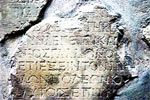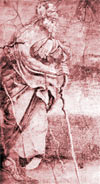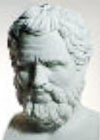For five centuries, Stoicism was the dominant philosophy of the Romano-Hellenic world. Rome’s educated elite found this import much to its taste. Stoicism was admirably suited to the builders of empire. It urged a dutiful self-discipline, detachment from the feckless passions, steadfastness in friendship and fortitude in adversity. It reasoned that all men were the offspring of God and therefore brothers, each deserving of compassion and justice. Stoicism made no vain promises of a life beyond the grave, though some Stoics thought it a possibility. Happiness was to be found within, in this life. Stoicism was manly, rational, and temperate. Its reward was virtue – “the highest good” – and perhaps the honour of a noble house.
Stoicism originated on the island of Cyprus with Zeno of Citium at the zenith of Greek expansion in the late 4th century BC, when the old gods were already in decay and rational thought in the ascendant. It took its name from the ‘Stoa’, or colonnade, at Athens where Zeno taught. Though pantheistic – conjecturing God as present in all things and not transcendent – Stoicism provided many of the building blocks out of which the early Christians built their religion.
Indeed, the first “pagan” Christians had trained in the Stoic tradition (Pantaenus, Clement, et al) and carried into the new faith the asceticism, seclusion, coarse dress and hirsute appearance which were all the marks of the Stoic sage on his way to “Perfection”.
Stoicism furnished the Christians with theory as well as practice. Zeno’s primary agent of creation, a material “Mind” in the guise of an ethereal yet vivifying “fire”, had by the age of Cleanthes (mid-3rd century BC), become “pneuma” or “spirit” – and would show up as the “fiery Holy Spirit” of Pentecost.
“And there appeared unto them cloven tongues like as of fire, and it sat upon each of them.”
– Acts 2.3.
“God is near you, he is with you, he is within you. This is what I mean, Lucilius: a holy spirit indwells within us, one who marks our good and bad deeds, and is our guardian. As we treat this spirit, so are we treated by it. Indeed, no man can be good without the help of God. Can one rise superior to fortune unless God helps him to rise? “
At the same time Philo was laying the foundations of Christian theology in Alexandria, in Rome, another educated aristocrat, Seneca, was articulating the highly developed morality and ethics of Stoicism. The two philosophers may even have met: Seneca took a long sojourn in Alexandria in 31 AD.
Lucius Annaeus Seneca (4 BC-65 AD) was a prodigious writer. His legacy includes satires, tragedies, several books on natural phenomena, and at least 124 insightful letters (Epistulae morales). A dozen essays on philosophy include edifying tracts on the brevity of life, human destiny, clemency and virtue. In On Clemency, Seneca describes the prince who safeguards the lives of his subjects as “god like”. In On Tranquility of Mind, he urges a contentment gained from thrift rather than a ceaseless passion for wealth. A lost work De superstitione ridiculed popular conceptions of the gods.
As it happens, the life of Seneca, like that of Philo, was contemporaneous with the “Jesus” of legend. Yet though Seneca wrote extensively on many subjects and people, nothing relating to “Jesus” ever caught his attention, nor does he show any awareness of a “vast multitude” of Christians, supposedly, punished for the fire that ravaged Rome in 64 AD.
Seneca had a privileged upbringing. Born in Cordoba, he was the son of a famous father, Marcus Annaeus Seneca (Seneca the Elder, 54 BC-39 AD), himself a prolific writer of legal commentary, history and philosophy. Both father and son were of the Stoic school.
The younger Seneca was sent to Rome as a youth, where he studied philosophy and law. He became a successful politician, but fell into disfavour when Messalina, wife of Claudius, persuaded the emperor to have him banished to Corsica. The charge was adultery with Julia Livilla, a sister of Caligula, and a rival Messalina wanted out of the way. After eight years in exile, Seneca was recalled by Claudius’s second wife Agrippina and over the next several years he attained great influence as the tutor of the future emperor Nero.
As a leading politician (Praetor in 48, Consul in 57), Seneca was himself a witness to the intrigue and violence of the imperial court during the reigns of Caligula, Claudius and Nero. It eventually cost him his life. Though arguably compromised by his own accumulation of great wealth, Seneca remained ever the philosopher. His adaptations of Greek classics were infused with the humane and moral message of the Stoics. A favourite theme of Seneca’s work was the contradiction inherent in kingship, the conflict of power with moral purpose.
In Hercules Furens (“The Madness of Hercules”), one character laments crime masquerading as virtue and the triumph of might over right; another warns bloodied tyrants that they will one day face judgement. In Thyestes, the protagonists mirror the behaviour of Rome’s own leaders, scheming for power and destroying each other’s children in the process. Kingship is linked to a sacrificial lamb and human flesh is eaten (“Thyestian Feast”).
Seneca’s dramas (like the Gospels, in fact) were written to be read privately or recited at small gatherings rather than be performed. It is more than possible that the high drama of “Passion week” owes its theatrical form to the hand of Seneca. In De Ira (1.2) (about 41 AD) he writes:
“Behold all the leaders who have been handed down to posterity as instances of an evil fate. Anger stabbed this one in his bed, struck down this one amid the sanctities of the feast, tore this one to pieces in the very home of the law and in full view of the crowded forum, forced this one to have his blood spilled by the murderous act of his son, another to have his royal throat cut by the hand of a slave, another to have his limbs stretched upon the cross.”
“In such a manner did Claudius meet his end. It seemed as if this event had been indicated by the comet, which was seen for a very long time, by the shower of blood, by the thunder-bolt that fell upon the standards of the Praetorians, by the opening of its own accord of the temple of Jupiter Victor, by the swarming of bees in the camp, and by the fact that one incumbent of each political office died.”
– Dio Cassius. Book 61.35
Seneca’s longest play, Hercules on Oeta, portrays the death and deification of Hercules. The hero is betrayed by those close to him, but, free from his mortal body, his celestial spirit conquers death – in essence, a resurrection. Given the distrust held by Stoics for those who grasp for power, it is more than possible that Seneca wrote a drama in which a low-born, counter-hero – a Stoic no less – suffers the same Noble Death. It could then have been plagiarised for the “Passion Week” of the Jesus saga.
In 65 AD, Seneca was accused of being a part of the Calpurnius Piso conspiracy to assassinate Nero, and was forced to commit suicide.
The lack of any reference to Jesus Christ or Christians by Seneca was an embarrassment rectified during the 4th century by a forger familiar with Seneca’s letters to his life-long friend Lucilius. What emerged was a correspondence purporting to be friendly exchanges between the eminent Roman philosopher – at the height of his fame and political influence – and an unknown itinerant preacher we now call St Paul.
The lack of any reference to Jesus Christ or Christians by Seneca was an embarrassment rectified during the 4th century by a forger familiar with Seneca’s letters to his life-long friend Lucilius. What emerged was a correspondence purporting to be friendly exchanges between the eminent Roman philosopher – at the height of his fame and political influence – and an unknown itinerant preacher we now call St Paul.
The catalyst for the fabrications appear to have been remarks by Tertullian, in the early 3rd century. Tertullian, aware that Seneca had articulated sentiments suited to a “great moral teacher” referred to Seneca as “often our own.” By the time of Constantius II (337-361), Seneca had been taken captive by the Christians, his fidelity to the cause vouched for by a lively exchange of letters (in Latin!) with the Jewish Christian apostle. We are asked to believe that Seneca wrote eight letters to Paul and received six replies. As if.
“The tradition that Gallio sent some of St. Paul’s writings to his brother Seneca is utterly absurd; and indeed at this time (A.D. 54), St. Paul had written nothing except the two Epistles to the Thessalonians.”
The pen of a 4th century fraudster has one of the richest, most powerful men in Rome wishing he could swap places with the unknown Jewish apostle from Tarsus!
” Hail, my dearest Paul … so great a man, so beloved in all ways … You are the summit and topmost peak of all people …
We were much refreshed by the reading of … the many letters which you have addressed to some city or capital of a province .. which inculcate the moral life with admirable precepts…
Such is the greatness of them … such nobility, that I think whole ages of men could hardly suffice for the instilling and perfecting of them … For it is the holy spirit which is in you and high above you which expresses these exalted and adorable thoughts.
I am glad as to be counted a second self of yours … For the rank that is mine, I would it were yours, and yours I would were mine.
Yet no one before the time of Constantius II knew of any such letters. Eusebius of Caesarea (c.263-339) – a liar for God, if ever there was one – makes reference to Paul, his “brief epistles” and Nero but says nothing of Nero’s tutor and “chief minister”, Seneca.
“Paul, for instance, who surpassed them all in vigor of expression and in richness of thought, committed to writing no more than the briefest epistles, although he had innumerable mysterious matters to communicate”
– Church History, 3.24
“Paul spent two whole years at Rome as a prisoner at large, and preached the word of God without restraint. In this imprisonment he wrote his second epistle to Timothy …
But hear his testimony on these matters: “… I was delivered out of the mouth of the lion” referring, in this expression, to Nero, as is probable on account of the latter’s cruelty. ”
– Church History, 2.22
Another dubious link to the illustrious Seneca family was made using Seneca’s older brother Novatus. It seems that Novatus, who took the name of his patron Junius Gallio, served briefly as proconsul at Achaia (Greece). The 2nd century author of Acts – gleaning the name Gallio from a secular source which mentioned the proconsulship – used this tidbit of circumstantial detail for a supposed trial in Corinth of the apostle Paul before governor Gallio.
The medieval Golden Legend tidied the fantasizing up nicely, with Nero witnessing Seneca’s suicide after his conversion to Christianity by Saint Paul!



